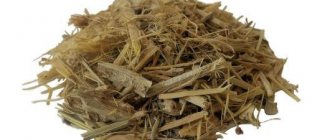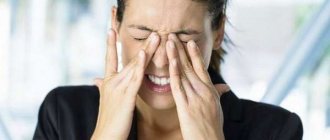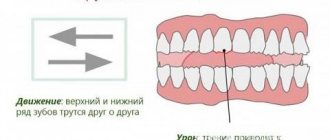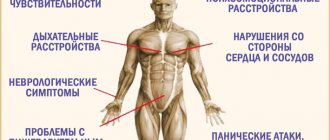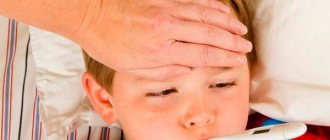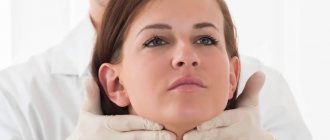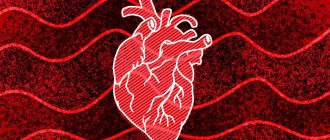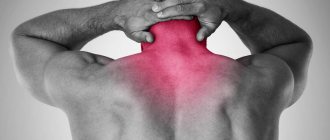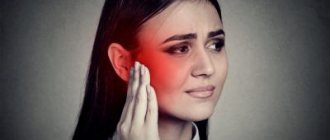Ivan Drozdov 12/20/2017 0 Comments
Migraines occur several times more often in women than in men. The disease manifests itself especially clearly during reproductive age, when hormonal changes occur against the background of ovulation. But there are other reasons for the development of pulsating, severe headaches, which, by their manifestation, significantly reduce mental and physical activity. They are hereditary or pathological in nature, and require treatment by specialized specialists.
general description
Migraine headaches are rarely localized in both halves of the head, and, as we have already highlighted, its appearance is not associated with any concomitant conditions that could explain it. The nature of such pain is associated not with traditional headaches that occur against a background of tension, but with blood vessels. Moreover, with migraine, headache has nothing to do with blood pressure (with its increase or decrease), just as it is not associated with increased intracranial pressure or an attack of glaucoma, which defines it, in combination with the listed descriptions, as a special type of manifestation of headache.
The main factor provoking the risk of migraine is a predisposition due to heredity, although in general the reason acting as a substantiating factor has not been determined to date due to the complexity of the mechanism of development of this condition.
Provoking factors also include physical and emotional overload, alcohol consumption (in particular champagne, red wine, beer), eating and sleeping disorders, excessive exposure to noise and sunlight (overheating), smoking, climate change and weather conditions in general, changes in hormonal levels in the female body (including during the use of hormonal contraceptives), as well as changes associated with the menstrual cycle. It is noteworthy that tyramine-rich foods (such as cocoa and chocolate, cheese, coffee and nuts, citrus fruits and smoked meats) lead to disturbances in the functioning of the central nervous system regarding serotonin processes, which, in turn, makes it possible to consider them as factors directly related to the development of migraine.
When examined at a deeper level, the situation with the development of migraine against the background of these factors looks like this. In particular, they lead to the development of vasospasm in the carotid or vertebrobasilar system, which, in turn, provokes characteristic symptoms in the form of photopsia, loss of visual fields, and numbness of one of the limbs. All this can be reduced to determining the specific stage to which these symptoms indicate; this stage is prodromal. Gradually, the next stage begins, accompanied by pronounced dilatation, which covers arterioles and arteries, veins and venules, especially this process is expressed in the region of the branches of the external carotid artery (menopausal, occipital and temporal).
Next, there is a sharp increase in the amplitude of the walls of the vessels that have undergone dilation, as a result of which the receptors in the walls of the vessels are irritated, which, accordingly, leads to a localized and severe headache. Subsequently, due to increased permeability, the walls of blood vessels begin to swell. As a rule, at this stage of the process, muscle contracture of the neck and scalp is formed, as a result of which blood flow to the brain is significantly increased. Following this, quite complex changes occur at the level of biochemical processes, during which histamine and serotonin are actively released from platelets, due to which the capillaries become more permeable, which, in turn, narrow along with a narrowing of arterial tone. All this leads to the third stage of migraine.
In the future, against the background of these processes, patients may encounter symptoms that indicate that the hypothalamus is also involved. These symptoms manifest themselves in the form of chills and low blood pressure, low-grade fever and frequent urination.
When the attack ends with the onset of sleep, the headache disappears when the patient wakes up, but instead, general weakness may be noted in combination with malaise.
The fourth stage of migraine manifests itself in the form of a post-migraine symptom, as well as in the form of allergic-type disorders and angiodystonia.
Returning, again, to the causes of migraine, it is important to note that the leading role in its development is given to the activation process in the trigeminal nerve nucleus. In this case, migraine is a relevant condition for people with increased social activity, as well as for people who are overly ambitious and anxious.
The disease is predominantly observed at a young age, with its onset occurring before the age of 20, and its peak at the age of 25 to 35 years. Modern statistics indicate that migraine is diagnosed in 20% of cases among women and about 6% among men. Migraine in children cannot be ruled out - symptoms of this condition are observed in about 4% of cases.
When considering heredity in favor of the subsequent occurrence of migraine in a child, the presence of migraine in both parents increases this risk to 90%; if only the mother has migraine, the risk of development reaches 70%; The presence of only the father determines the risk of developing migraine within up to 20%.
Extended types of syndrome: ocular, cervical form
Simple spasms can affect neighboring areas, provoking the development of various diseases and complications. The cervical form of migraine is an extended pathology of the usual process, in which, in addition to the temples and forehead, the cervical region and the occipital region hurt. In addition to the neck, spasms can spread to the arms and shoulders.
There are two theories for the development of pain syndrome. They boil down to the fact that due to spasms, the blood vessels narrow and swelling forms. With cervical pathology, the nerve endings are pinched, so unpleasant discomfort occurs in the cervical as well as the occipital region.
Manifestation of migraine in the cervical region
The ocular form of the disease is spasms accompanied by visual impairment. The patient sees poorly, flickering appears before the eyes. The attack is accompanied by glare, sudden flashes, spots, and sometimes short-term blindness is observed.
Eye spasms differ from simple pains - they last less than 2 hours (a regular migraine lasts 2-3 days).
Ocular form of the syndrome
Migraine: symptoms
The main manifestation of the disease, as we have already found out, is a paroxysmal headache, most often concentrated on one side of the head in the frontotemporal region. The pain is often pulsating and intense, in some cases accompanied by nausea (and sometimes vomiting); photophobia and sound sensitivity cannot be ruled out. In particular, pain increases with excessive stress of a different nature (mental stress, emotional or physical stress).
An attack of the disease can occur at any time, and it often happens that a migraine appears during sleep (at night), closer to the morning, or upon awakening. Mostly the pain is unilateral, but later it becomes dispersed to both sides of the head. As for nausea (with vomiting added in some cases), it appears mainly towards the end of the pain phase, although the possibility of its appearance along with the attack itself cannot be ruled out.
The period of the attack leads, as a rule, to the desire of patients for solitude, with darkening the room from excess sunlight and adopting a recumbent position. Based on the frequency of attacks, they may occur either in the form of several episodes throughout life or in the form of occurring several times a week. Most patients experience up to two attacks per month. In general, an attack can last from an hour to three days, although its duration is usually noted to be within 8-12 hours.
Migraine during pregnancy generally weakens in its manifestations, although the opposite effect cannot be ruled out, in which attacks in its manifestations, on the contrary, intensify or even appear for the first time precisely at this time. The nature of migraine, as we have already noted, is largely hereditary, and, basically, heredity comes from the maternal line. The interictal period does not determine the focal type of neurological disorders during a neurological examination.
Let us consider some of the main types of migraine in more detail regarding their manifestations and features of the clinical picture.
The mechanism of development of migraine headaches
As you know, migraine is a special type of headache, the mechanism of development of which is unique and unlike any other. Therefore, most headache medications are ineffective for migraines.
A migraine attack occurs in several successive phases:
- Spasm of the arterial vessels of the brain and the development of short-term hypoxia of the brain. It is with this phase that the development of migraine aura is associated.
- Then comes dilatation, or expansion, of all types of brain vessels (arteries, veins, venules, arterioles and capillaries). At this stage, a typical throbbing headache develops.
- Swelling of the walls of blood vessels and the perivascular space develops, which makes them rigid to signals for reverse narrowing. This phenomenon determines the duration of migraine headaches.
- The last stage is characterized by the reverse development of migraine and is also called post-migraine syndrome. For some time after the pain stops, the patient may complain of general weakness, fatigue, and a feeling of “staleness” in the head.
Despite the available data on the nature of migraine headaches, new information appears every day, as this problem is actively studied by scientists around the world. For example, according to recent medical publications, the hypothalamus of the brain plays a significant role in the pathogenesis of migraine, and this provides new opportunities for the invention of effective drugs for the treatment and prevention of migraine.
Migraine without aura: symptoms
This type of migraine is also defined as simple migraine. This type is the most common; it occurs in about 2/3 of the total number of diseases under consideration. It is noteworthy that women experience migraine attacks much more often before or immediately during their menstruation. It also happens that attacks of this type of migraine occur only on specific days of the cycle.
The diagnosis of migraine without aura is guided by a number of criteria, which in particular include the following:
- occurrence of seizures at least five times;
- the total duration of each of these attacks is from 4 to 72 hours in the absence of adequate therapy;
- correspondence of actual headache to at least two of the following characteristics:
- pulsating nature of manifestation;
- localization on one side;
- the average degree of intensity of manifestations or their severe degree, due to the occurrence of which patients lose the ability to carry out their usual activities;
- a noticeable increase in symptoms during physical activity or when walking;
- the appearance of nausea (possibly with vomiting) in combination with a headache;
- sound phobia;
- photophobia.
How to treat the disease
If a migraine attack begins, what should you do, how to treat migraine, what methods of treating migraine does modern medicine use?
Treatment of the disease meets two main principles:
- Relief of pain during an attack.
- Migraine prevention.
Treatment of migraine during an attack:
- The best advice that can be given to a person in this condition is to contact a specialist; prescriptions from the attending physician will take into account the general condition of the patient’s body. A neurologist will be able to select an adequate treatment that will help quickly relieve pain;
- If it is not possible to see a doctor, you should know which medications you should take on your own so as not to cause irreparable harm to the body.
Migraine treatment for mild or moderate attacks that last no more than two days is carried out with weak painkillers and non-steroidal anti-inflammatory drugs (NSAIDs), they cope with the problem quite well, you just need to remember the contraindications.
- Paracetamol or Ibuprofen - these analgesics are contraindicated in cases of detected liver or kidney pathology.
- Aspirin (acetylsalicylic acid) is contraindicated for diseases of the gastrointestinal tract, poor blood clotting, and bleeding.
- Combined-action painkillers containing phenobarbital, codeine and metamizole sodium also have a number of contraindications.
Migraine, which has symptoms in the form of an aura and very intense, prolonged pain, is treated only by a specialist; self-medication can significantly harm a person.
Ophthalmoplegic migraine: symptoms
This type of migraine is quite rare with the prevailing symptoms of damage to the eyeballs and unilateral paralysis. It is characterized by the development of a number of oculomotor disorders, which can be transient in their manifestations. They can occur at the peak of pain during a headache or at its very beginning, consisting in the following conditions: strabismus, dilation of the pupil on the side of the localization of pain manifestations, double vision, drooping of the upper eyelid on the side of pain manifestations, etc.
Most patients experience the development of the disease when it alternates with attacks, during which the appearance of a typical aura is noted. Visual pathologies in this condition with the appearance of an aura are reversible, that is, they disappear after some time.
Botox in the treatment of pain syndrome
This method is very often used by doctors, as it has proven itself on the positive side. Botox is an effective prevention of migraine in adult patients. The product is administered as an injection into the neck and head every 3 months. Such injections cope well with painful discomfort and also control further manifestations of the disease.
A remedy such as Botox is effective for chronic pathologies. Its effect on periodic diseases has not been proven. A common side effect is pain in the cervical spine and head.
Migraine treatment is carried out by other methods, including: subcutaneous administration of histamine, the use of ACE inhibitors, neurostimulation, nasal powders and sprays, dietary supplements and herbal decoctions.
Botox is an effective prevention of the syndrome
Hemiplegic migraine: symptoms
Hemiplegic migraine is a relatively rare type of the disease we are considering; its peculiarity is the appearance of temporary and recurring weakness on one side of the body. The very concept of “hemiplegia” defines muscle paralysis itself, which affects one side of the body.
Hemiplegic migraine is predominantly observed in those patients whose parents also had a tendency to have such attacks. Before making a diagnosis in this variant of the disease, it is not based solely on the actual attacks of muscle weakness, but it is quite sufficient to use the data of a computed tomogram.
Treatment without the use of drugs
Is it possible to cure migraines without using medications? How to cope with migraines without them? There are different ways that make it possible to avoid painful attacks and make your life fulfilling.
Among them are techniques that allow a person to gain control over the physical reactions of the body. Having mastered them, the patient, feeling the approach of pain, can change the tension in the muscles, control his general physical condition, which leads to relief of the attack.
Relaxation is another effective technique that teaches you to completely relax in anticipation of pain and control your breathing; its correct use can also significantly relieve pain.
Many people faced with overwhelming pain recommend adding herbal treatment to the medication, as well as taking certain vitamins. Such complex therapy allows not only to relieve pain, but also to greatly reduce the number of attacks. For example:
- vitamin B2 (riboflavin) and magnesium are the medications that are recommended to be taken if you have an illness. They will help reduce the tone of blood vessels in the brain, which serves as a good prevention of migraines;
- fatty acids (can be found in fish oil, flaxseed or olive oil) - also worth taking for people suffering from migraine attacks. These substances perfectly calm the nerves, relieve inflammation, and therefore are a good prophylactic agent;
- Among the beneficial plants used to prevent disease, ginger is especially worth highlighting. The root of this plant, consumed in the form of infusions or raw (in small quantities), not only relieves nausea during an attack, but also taken regularly significantly reduces the number and duration of pain attacks.
By understanding what migraine is, its symptoms and treatment, you can find different ways to make your life easier and get rid of pain.
Ocular migraine: symptoms
Ocular migraine, which is also defined as scintillating scotoma or migraine with aura, is a disease whose symptoms consist of periodic disappearances within a certain visual field of the image. Ocular migraine is observed quite often in patients, and although the name of the main term that defines it indicates pain, in reality the disease in this form is not accompanied by it. Meanwhile, the option of a combined course is not excluded, that is, a combination of ocular migraine with regular migraine, which occurs due to a violation of blood circulation in the brain.
When defining the features of ocular migraine, it should be noted that it implies a neurological process that appears in the form of a response to certain changes occurring in the body. In particular, such changes include changes in hormonal levels, changes associated with the characteristics of the chemical composition of consumed products, changes provoked by drugs used by patients, etc.
As a result, a headache may appear, and it can last for several hours or several days. Due to impaired blood circulation in the areas of the brain responsible for vision (they are concentrated in the occipital lobe), ocular migraine can also subsequently develop.
Ocular migraine, the symptoms of which, according to its name, consist of visual pathologies, can manifest itself in different ways. Ocular migraine predominantly manifests itself from a scotoma (or the so-called “visual spot”) of small size, concentrated in the center of the patient’s field of vision; in addition, it can manifest itself in the form of zigzag lightning or flickering within the blind spot. This spot, in turn, can increase in size, moving along the field of view. The duration of this phenomenon can be on the order of several minutes, but it mostly disappears after about half an hour.
This type of migraine accounts for about a third of cases of this disease in general. It is noteworthy that in some cases, the symptoms characteristic of visual migraine are also accompanied by the appearance of unilateral paresthesia (that is, sensations in which numbness occurs in a certain area of the body), and speech disorders are diagnosed somewhat less frequently. Numbness, in particular, can affect both half of the body and half of the face, the tongue, and weakness in the limbs in combination with speech disorders is much less common.
An important feature is that the appearance of neurological disorders, for example, on the right side (that is, disorders in the form of the listed symptoms), indicates that the localization of the headache itself is concentrated on the opposite side, that is, on the left. If the localization is concentrated on the left side, then the pain, accordingly, is felt on the right.
Only in about 15% of cases the localization of neurological disorders and headaches coincides. After the end of the aura, which in itself is the definition of the listed complex of neurological symptoms that arise before the migraine with accompanying pain or symptoms noted directly at the onset of the migraine, pain of a pulsating nature appears, concentrated within the frontotemporo-orbital region. This pain increases over a period of half an hour to an hour and a half, which may be accompanied by nausea and, in some situations, vomiting. The vegetative form of this condition is accompanied by the emergence of fear and panic, trembling appears, and breathing quickens. It is noteworthy that any symptoms characteristic of a migraine with the appearance of an aura are reversible, which we have also previously noted.
It also happens that migraine leads to complications, one of them is status migraine. It means a series of fairly severe migraine attacks that follow each other in combination with repeated vomiting. The appearance of attacks occurs at intervals of about 4 hours. This condition requires inpatient treatment.
Prevention and some recommendations
Women most often remember migraine symptoms, which are quite debilitating, during hormonal changes. Therefore, the patient (regardless of age) should be provided with comfortable conditions. A teenager needs to give up classes at school and study better at home. The home atmosphere should be friendly and calm.
Children with a genetic predisposition to seizures have a vulnerable psyche. They cannot stand criticism, they worry even when their parents argue or scold their neighbor’s child.
Once the teenager’s body has readjusted itself, seizures will occur much less frequently. The first signs of a migraine are a danger signal. For 2-3 years it is necessary to limit the stress on the psyche and nervous system. If you are prone to seizures, you should treat the patient with care while waiting for the baby and after - during menopause (at 50-55 years).
Is migraine dangerous, because this disease can lead to various consequences. The strength and frequency of attacks depends on heredity, but they can be aggravated by an unhealthy lifestyle and poor nutrition. Sometimes pain occurs for no apparent reason.
Effective migraine prevention:
- The drug "Timolol" 10/20 mg.
- Medicine "Metoprolol" 100/200 mg.
- Propranolol 80-160 mg.
β-blockers can cause fatigue and should not be taken by asthmatics or those with severe heart disease.
Before an attack occurs, you can take the following medications:
- “Sodium Valproate” 200 mg – increases weight, causes drowsiness. In 15% of patients their use is impossible;
- "Methysergide" most likely helps not to cure the disease in the early stages, but to stop its development. A side effect is unpleasant discomfort in the abdominal area, sometimes fibrosis;
- “Dothiepin” or “Amitriptyline” before bedtime 25 mg - has analgesic properties if spasms occur due to a stressful situation;
- "Aspirin". Treatment with this medicine does not bring the expected result, so it is used in rare cases;
- Pizotifen 1.5-3 mg. The disease can be treated in its early stages using this remedy. The drug increases body weight, so it is contraindicated for many patients; increased dosage, gradually over the course of a month, helps eliminate drowsiness.
What migraine is and how to get rid of it, no specialist still fully knows. But if this disease has been identified, therapy must be started as quickly as possible. The doctor will tell you how to treat the pathological condition.
Each patient must support his body, carry out preventive therapy for the disease - multivitamin complexes, massage. This technique will reduce the frequency and severity of attacks.
There must be supportive therapy
Migraine: symptoms in children
Headaches in children are not uncommon; moreover, vigilant parents do not rule out the need to consult a doctor for this reason, which, however, does not always make it possible to find out the cause of this condition. Meanwhile, pain attacks accompanied by general malaise, in many cases, mean nothing more than a migraine.
This disease is not accompanied by any specific objective data, because the temperature and pressure with it generally correspond to normal values, and tests also do not indicate the relevance of certain abnormalities for a small patient. Actually, examination of children in this case does not determine any specific changes regarding the functioning of individual systems and organs. Be that as it may, statistics on children indicate that by the age of 14, about 40% of them have experienced migraine, moreover, about 2/3 of them inherited it from their parents.
The reason for headaches in children with migraine is that this condition is accompanied by increased production of adrenaline (which, in fact, is also true for adults). This hormone, in turn, constricts the blood vessels of the brain for a certain time (which, as we previously noted, can range from several hours to several days), and the vessels in this case stop responding to therapy acting in the form of certain drugs, which significantly complicates matters. In particular, due to the narrowed lumen of blood vessels, the process of blood flow to the brain along with the delivery of the required nutrients to it is significantly disrupted.
Against the background of such fasting, severe headaches appear. We also note that nervous overstrain is identified as a factor provoking such an attack by adrenaline, which, you see, is a fairly common condition for children. It is noteworthy that this tension can be relevant both for relaxation (computer games, TV, etc.) and for intensive training with stress against the background of responsibility associated with this training. It should also be noted that certain foods can lead to migraine, as well as the predisposition already noted initially, inherited from the parents.
And if everything is more or less clear with hereditary predisposition, then food products in this context require some attention if migraine appears against the background of their consumption. This may consist in elementary intolerance to certain foods, which, in turn, determines the need to change the diet, as well as prescribe an appropriate diet aimed at preventing migraines based on the food factor of influence. Let us highlight the main symptoms accompanying migraine in children:
- headache (mostly unilateral);
- nausea, in some cases – vomiting;
- increased sensitivity to light;
- speech disorders;
- dizziness;
- reduction of the visible field of view.
Experimental treatments for migraine
Experimental methods include treatment using hypnosis, electronic devices, and a special adhesive plaster. However, there is no evidence of their effectiveness and more research is needed.
Due to the disruption of cellular metabolism and activation of lipid peroxidation that occurs in the pathogenesis of migraine, along with conventional drug treatment, the prescription of antioxidants and metabolic drugs that improve energy processes in cells and protect them from damage by free radicals (a combination of vitamins A, E, C, coenzyme Q10, antioxycaps, emoxypin).
For example, a study was recently published that involved 1,550 children and adolescents suffering from frequent migraine attacks. It showed that a number of patients had low plasma levels of coenzyme Q10, and that the recommendation of dietary supplements containing coenzyme Q10 may lead to an improvement in some clinical signs. The authors concluded that to confirm such observations, analyzes with more scientifically sound methodology are required.
In another study of 42 patients, the authors compared the effectiveness of CoQ10 (300 mg/day) and placebo: CoQ10 was significantly more effective than placebo in reducing the frequency of migraine attacks, the duration of headache attacks, and the duration of nausea attacks after 3 months of treatment. The authors evaluate CoQ10 as an effective and well-tolerated means of preventing migraine manifestations.
A team of plastic surgeons at University Hospitals of Cleveland has been working for about a decade on the hypothesis that in some cases, the cause of recurrent headaches and migraines is irritation of the trigeminal nerve caused by spasm of the muscles around it. Studies have been published confirming that headaches are reduced or eliminated by Botox injections and surgical removal of the associated muscles.
Cervical migraine: symptoms
When considering migraine, this type should not be missed. It has a number of names: this is, in fact, “cervical migraine”, and “sympathetic cervical syndrome (posterior)”, and “vertebral artery syndrome”. Any of the listed options can be used to diagnose a specific condition, however, in any of its options, in essence, we are talking about the same condition.
Cervical migraine refers to a condition in which the blood flow to the brain through the pool of one or two vertebral arteries at the same time is disrupted. Let us dwell in more detail on the essence of this process.
The blood supply to the brain, as you may know, is provided by two pools. The first of them, the carotid basin, contains the carotid arteries. At their expense (or, to be more precise, at the expense of the main branches in the form of the internal carotid arteries), up to 85% of the total blood flow to the brain is ensured, as well as being responsible for various types of disorders associated with blood circulation (primarily strokes). ). It is the carotid arteries that receive particular attention during examinations, and in particular, it is given to their atherosclerotic lesions in combination with current complications.
As for the second basin, this is the vertebrobasilar basin, which includes the vertebral arteries (on the left and right sides). They provide blood supply to the posterior parts of the brain along with about 15-30% of the total blood flow to it. A lesion of this type, of course, cannot be compared with a lesion due to a stroke, but disability cannot be ruled out with it.
When arteries are damaged, the following conditions are noted:
- dizziness;
- severe headaches;
- visual and auditory impairments;
- coordination problems;
- loss of consciousness.
As for the reasons that can provoke such a defeat, they can be divided into two corresponding groups:
- nonvertebrogenic lesions (that is, lesions whose occurrence is not associated with the spine) - lesions caused, as a rule, by atherosclerosis or congenital anomalies associated with the characteristics of the course of the arteries and their size;
- vertebrogenic lesions (respectively, lesions that arose against the background of a pathology relevant to the spine) - here, in particular, we are talking about a particular disease of the spine, which acts as a predisposing factor to the lesion. The traumatic nature of this lesion cannot be ruled out, which may be associated with the general history of the patient’s adolescence and the injuries accompanying this period, however, changes of the most pronounced scale are observed to a greater extent in adults, which is compared with the development of osteochondrosis in them.
The listed reasons initially irritate the sympathetic plexuses in the vertebral arteries, subsequently leading to spasm, after which compression of the arteries occurs along the course of the bone canal or at the exit of the artery from it, which, in turn, leads to the development of circulatory disorders. The latter have a short-term manifestation and occur when the head tilts or turns, as well as when a person changes body position.
Dwelling on the symptoms that are relevant for the condition we are considering, we highlight that the main one, as we noted earlier, is headache. It is constant in its manifestation and in some cases intensifies in the form of severe attacks. In some cases, the pain is burning or throbbing and is concentrated in the back of the head. The possibility of pain spreading to other areas of the head is not excluded (irradiation is often noted, that is, spread to the bridge of the nose and to the orbit, etc.). Pain intensifies with neck movements. Quite often, this symptomatology is also accompanied by pain noted in the scalp, which occurs even with a slight touch to it or while combing it.
Tilts of the head and turns are accompanied by a characteristic crunching sound, possibly a burning sensation. Also, some patients experience conditions generally characteristic of migraine of any type in the form of nausea with possible vomiting, ringing in the ears, noise in the ears (often in combination with synchronous heartbeat). Raising the head up is accompanied by dizziness, which occurs as a result of the artery moving towards the narrow part of the opening. In the case of atherosclerosis that is relevant to the patient, in this case, dizziness appears as a result of tilting the head forward.
Already specific, one might say, symptomatology is the appearance of visual disturbances (in the form of the appearance of “floaters” before the eyes, a decrease in visual acuity in general, double vision and blurred vision, etc.). Possible hearing loss. In some cases, the possibility of a swallowing disorder combined with the sensation of a foreign object in the throat cannot be ruled out.
It is noteworthy that compression of the vertebral artery often leads to paroxysmal conditions that occur as a result of turning the head. Thus, turning the head may be accompanied by a fall of the patient (he falls “as if knocked down”), and in this case loss of consciousness does not occur; he can get up on his own. It is also possible that a sudden movement of the head leads to a sudden fall, but this is accompanied by loss of consciousness. A person can come to his senses within 5 to 20 minutes and can get up on his own, but for a long time after this he experiences weakness. In addition to the above, autonomic disorders are also possible, which may include feelings of hunger, chills, and fever.
Causes
The causes of migraine in women have a very variable etiology. At the level of guesses and studies with twins, descriptions of clinical cases and differentiation of migraines into types, the only general conclusion is a hereditary predisposition transmitted at the gene level.
According to representatives of various scientific medical schools involved in research on this problem, the causes of migraine should be distinguished from its provoking factors.
The negative influences that cause an attack are not what leads to the potential occurrence of such a pathology.
But what exactly is included in the pathophysiology of the disease has not been proven with a sufficient degree of certainty, even by numerous studies.
The main hypotheses that explain the causes of migraine in women at different levels are based on the preliminary exclusion of the most likely causes of headaches.
Blood pressure, intracranial pressure, and glaucoma are excluded, there are no injuries or tumors, no stroke or heart attack.
When deciding what the causes of migraine are, medicine chooses from the following possible assumptions:
- a consequence of narrowing of arterioles, which caused a deterioration in the blood supply to the brain;
- reduced reactivity of vascular structures of the brain to carbon dioxide;
- uneven dilation of blood vessels due to a specific or idiopathic reason;
- the development of a migraine attack occurs against the background of a disorder of the neurovascular activity of the central nervous system, leading to modifications in the process of vasomotor regulation;
- dysfunction of metabolic regulation that arose against the background of uneven distribution and metabolism of serotonin;
- genetic prerequisites caused by disruption of the cardiovascular system (this conclusion was made based on facts about a significant number of relatives with a history of hypertension in many patients undergoing treatment for the pathology).
As in many cases where the pathophysiology of the disease cannot be elucidated, there is speculation that the underlying cause is not the vascular abnormalities diagnosed in clinical studies.
Their frequency, relative to the total number of patients studied, does not provide much basis for broad generalizations.
However, the main reason may lie in insufficiently studied areas - lipid peroxidation, cellular energy metabolism, or in the mechanisms of adaptation of an open system to external environmental conditions.
Diagnosis
In a situation with recurring headaches, it is imperative to visit a doctor. Diagnosis is made on the basis of clinical indicators based on a survey of the patient and his general examination. It is important to consider that paroxysms of a condition relevant to migraine (that is, systematically recurring attacks) can act as the first symptom indicating a brain tumor or vascular malformation (in particular, this implies the possible relevance for the patient of developmental abnormalities, as a result of which pronounced changes in the functions of blood vessels and their structure).
Given the possible seriousness of the patient’s condition, a detailed examination is required to exclude an organic process. In particular, you will need to visit an ophthalmologist to check the fundus, visual acuity and visual field. You will also need electroencephalography, CT and MRI procedures.
Treatment tactics and what the doctor usually prescribes
Typically, a specialist prescribes triptans to the patient - medications that were developed more than 20 years ago and have proven themselves well. These medications act in several ways:
- have a pronounced analgesic effect, significantly reduce the sensitivity of the trigeminal nerve;
- selectively affect blood vessels, affecting only the vessels of the head (reduce pulsation), without affecting the entire body;
- have a positive effect on receptors that provoke painful sensations, significantly reducing pain;
- do not have a sedative or hypnotic effect and are eliminated from the body fairly quickly;
- Preparations are produced in various forms: tablets, solutions, suppositories, spray.
There are a number of contraindications for which taking such drugs is not recommended:
- pregnancy (substances contained in the drugs can cause miscarriage),
- elderly age,
- presence of chronic diseases.
As an additional treatment, the doctor may prescribe non-selective and psychotropic medications.
Prevention of the disease includes a whole range of measures, including giving up bad habits, adjusting diet, maintaining a sleep schedule and taking medications, which are usually prescribed by a doctor.
The main means used for preventive measures include:
- anticonvulsants;
- antidepressants;
- beta blockers.
All drugs prescribed as prophylaxis are usually started in small doses, gradually increasing them. It is recommended to take the drugs for several months; this is the only way to achieve a positive effect. Some patients suffering from severe migraine attacks are forced to take medications for a long time (1 year or longer). For rare attacks, medications can be taken intermittently.
Drug therapy
Upon completion of diagnostic measures, a treatment strategy is determined. Complex therapy is based on the use of medications in combination with psychotherapy sessions.
Migraine treatment can proceed in two directions:
- stopping the development of an attack;
- preventing the development of possible complications.
Migraine treatment at home is carried out using Magnesium Sulfate. This drug allows you to eliminate the lack of magnesium in the body, the deficiency of which can contribute to the occurrence of chronic headaches. It is important to pay attention to the fact that the cost of this drug varies from twenty-five to forty rubles per package of ten ampoules.
The complex treatment includes the use of anti-inflammatory drugs (Nurofen), mild antidepressants (Ergotamine and Novopassit), as well as beta blockers (Nebivol, Timolol). Among additional medications, sodium and calcium channel blockers (Propafenone and Amlodac) should be highlighted. In a situation where the occurrence of migraine is associated with a tumor of the thymus gland, surgical treatment methods are used. In this case, the patient undergoes a resection procedure.
In cases where the headache is associated with muscle tissue overstrain, patients are prescribed a Botox injection procedure. Injections are administered into the area of the back of the head, forehead and temples, which causes irritation of nerve receptors. The positive effect of one procedure lasts for four months. It should be noted that this type of therapy requires high financial costs, since the cost of one procedure is about twenty thousand rubles.
When talking about how to treat migraines, we should specifically mention triptans. This type of analgesics was created at the end of the nineteenth century. The use of such medications helps not only relieve the symptoms of the disease, but also reduce the likelihood of relapse. Triptans are prescribed to patients suffering from migraine in combination with severe maladjustment. Drugs in this category are serotonin derivatives and have a vasoconstrictor effect. In addition, taking triptans helps slow blood circulation and inhibit the trigeminal nerves.
One of the common causes of migraines is hunger or insufficient food intake.
Drugs from this group should be taken when the first attacks of the disease occur. It is not recommended to chew the tablets. In order to prevent the development of an attack, just one tablet is enough. If pain does appear, you should take a new dose of the drug after two hours. It is important to note that this category of medications has many contraindications and side effects. The use of triptans in combination with antibiotics, antidepressants and antivirals is strictly prohibited.


